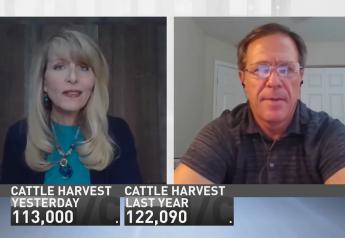Six Sources of Soybean Harvest Losses And How To Address Them

If you see handfuls of soybeans scattered about the field as you harvest they might not look like much, but small numbers can add up to huge losses quickly.
For medium-sized soybeans, four soybeans/ft2 is approximately equal to 1 bu. loss/acre, says Ken Ferrie, Farm Journal Field Agronomist and owner of Crop-Tech Consulting, Heyworth, Ill.
He encourages farmers to evaluate how much harvest loss is occurring.
"When you see yields dropping in an area, my recommendation is that's the time to stop the combine – while you have evidence to work with – jump out and take a look at that crop. Look at the good areas for yield and then compare that to the poor areas,” advises Ferrie.
“Maybe drop some pins and make some notes to help us when we're trying to diagnose what's going on,” he adds.
Six Common Sources of Soybean Yield Loss
Here are six of the most common types of soybean yield losses, according to South Dakota State University (SDSU) Extension.
1. Shatter loss. These are additional beans lost onto the ground when pods open during the cutting and gathering process at the head.
2. Stubble loss. This loss occurs when pods are attached to the plant stem below the height of the cutterbar and remain there after the passage of the machine.
3. Loose stem loss. These losses are associated with pods attached to stems that are cut, but are not recovered by the head.
4. Lodging loss. These losses are associated with stems that are uncut but lie on the ground, or are pushed to the ground by the head. Pods attached and the beans enclosed are lost.
5. Separator loss. These losses occur when beans are not threshed, or are passed over the sieves and out the back of the combine with the chaff or straw.
6. Machine leakage loss. These losses occur in some machines as wear or lose fitting parts allow beans to leak from holes or gaps in components. This type of loss is visible as an abnormal concentration of lost beans along a line under the machine.
More information on sources of yield loss and corrective actions to take are available from SDSU Extension here:
Green Stem Syndrome Strikes Again
This year, farmers are seeing a significant amount of green stem syndrome in the upper Midwest. It's a condition that causes plant stems to stay green even after the pods and seeds are fully mature and have dried to acceptable moisture levels for harvest, according to Mike Staton, Michigan State University Extension.
Although certain viruses and foliar fungicide applications have been associated with green stem syndrome, Staton says the most frequent cause is physiological. Dry conditions existing during pod set and early seed development followed by adequate rainfall favor the development of green stems. The plant leaves produce more carbohydrates through photosynthesis than the reduced number of developing seeds can utilize, causing them to remain in the stem.
Here are four recommendations, Staton offers to address green stem syndrome. You can read his complete set of recommendations on how to address the syndrome here.
- It is critical to continue harvesting soybeans having green stems even though it requires slower travel speeds and closer attention to cutter bar maintenance, reel speed and position, and threshing adjustments. Waiting for the stems to dry down will lead to large shatter losses.
- If shatter losses are excessive, consider combining earlier in the morning or later into the evening when the pods have regained some moisture and are less brittle. However, this may increase plugging problems.
- Reduce your ground speed to 2.5–3.0 mph if necessary. This will reduce shatter losses and plugging at the cutter bar by providing a crisp sideways cut.
- Harvest at a 20- to 25-degree angle to the rows. This will improve cutter bar performance and provide more even feeding of the crop into the threshing cylinder or rotor. This may be the single most beneficial practice.
Tune-in to this brief video to hear Ken Ferrie address how to reduce soybean harvest losses:
Three Ways to Be a Successful Soybean Yield Sleuth
New Profit Calculator Reveals How Much Soybean Cyst Nematode Costs You By Field
Harvest Update: Corn and Soybean Progress on Track With 2022







